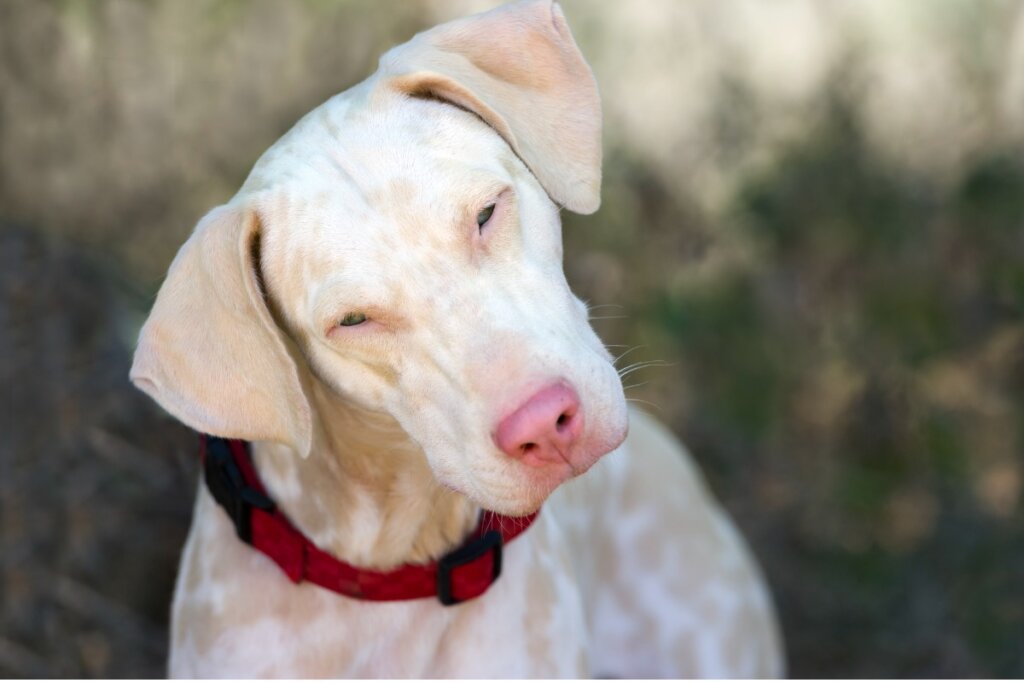Albino Doberman: All About this Breed

Albinism is a genetic mutation characterized by the absence of pigmentation in the individual’s skin, hair and eyes. It affects a multitude of species equally, but in today’s article, you’ll find information about the albino Doberman, a variety of this breed that suffers from this condition.
These dogs, like any other breed, require specific care that you should be familiar with, in order to give them a good quality of life. If you’ve ever seen, or live with, a Doberman with this mutation, here you’ll find all you need to know to look after them well, so don’t miss it!
Origin of the Doberman
This breed originated in Germany, where it was created when looking for a dog to accompany tax collectors. With this idea in mind, breeds such as the Rottweiler , the Beauceron, the Weimaraner, the Manchester Terrier, and the Pinscher were crossed, all to obtain a loyal dog with a threatening appearance.
Dobermans were later used as police dogs in this same region, as well as guard dogs in farms, and bodyguards. However, outside of law enforcement institutions this dog has become popular as a companion animal due to the strong bond it establishes with its owners.
Physical characteristics of the albino Doberman
An albino Doberman has the same physical characteristics as any of its breed, except that it suffers from a recessive inherited disorder (albinism) in which the metabolic pathway that transforms tyrosine into melanin (the pigment that colors the skin, iris and coat) is disrupted. Dobermans don’t have light coat colors unless they’re albinos.
So, these dogs have an all-white coat, as well as pink, unblemished skin and light blue eyes. Apart from this, Dobermans have a slender, athletic body despite their large size, about 70 centimeters (27.5 inches) at the withers.
Albino Doberman character
The temperament of this breed, although it varies from individual to individual, tends to be loyal and somewhat overprotective. They’re fearless dogs that won’t hesitate to confront any situation that they believe threatens their owner.
They’re dogs with a great facility for learning, so it’s good for you to take advantage of this quality in their training.
For this very reason, in addition to their great energy and size, these dogs require an education that reinforces socialization with strangers and other dogs. This is ongoing work, but, in return, you’ll enjoy a great companion to go out with for sport and excursions.
Due to the vision problems that come with albinism, an albino Doberman may have extra difficulties when it comes to socializing. However, it’ll only be necessary to adjust the training to this condition, as the dogs are guided primarily by smell.
Special care
The care of the albino Doberman is like that of any other dog of this breed. Here are some things to keep in mind with dogs with these characteristics:
- Maintain good dental and ear hygiene: All dogs with droopy ears are prone to infectious otitis. On the other hand, this breed is also prone to accumulate tartar and develop periodontitis if you don’t brush their teeth regularly.
- Vaccinations and deworming according to their schedule: As with any other dog.
- Routine check-ups at the veterinarian: It’s advisable not to skip them, especially because the professional will be able to observe in more detail any problem derived from albinism.
- Daily exercise: In addition to the abundant energy these dogs have, you need to keep their musculature in good condition to prevent or delay the onset of physical ailments typical of large breeds, such as hip dysplasia.
Care related to albinism
The skin and eyes are the two weak points of albino animals. The absence of pigmentation leads to the lack of the natural barrier that the body has to protect itself from solar radiation and its dangers. For this reason, an albino Doberman will be much more prone to skin cancer than one with melanin.
It’s advisable not to expose these dogs to sunlight and, when there’s no other choice, to use sun creams to protect them. In any case, you should avoid walking your albino Doberman albino during the hottest hours of the day and always seek shade, especially in the summer.
To further protect their skin, look for special shampoos and soaps for albino dogs or dogs with delicate skin.
The sun also causes discomfort to the light-colored eyes of albino animals. To avoid damage, you can get special glasses for dogs that will protect them from most ultraviolet radiation.
As you can see, these dogs have the same characteristics as any other Doberman, although some extra care will be needed. Remember that adopting is always a good option, as this reduces the demand for dogs bred for specific purposes and those with congenital problems associated with their breed
All cited sources were thoroughly reviewed by our team to ensure their quality, reliability, currency, and validity. The bibliography of this article was considered reliable and of academic or scientific accuracy.
- Doberman Pinscher Club of America. (2020, 10 abril). (2020). FCI.
- Winkler, P. A., Gornik, K. R., Ramsey, D. T., Dubielzig, R. R., Venta, P. J., Petersen-Jones, S. M., & Bartoe, J. T. (2014). A partial gene deletion of SLC45A2 causes oculocutaneous albinism in Doberman pinscher dogs. PLoS One, 9(3), e92127.